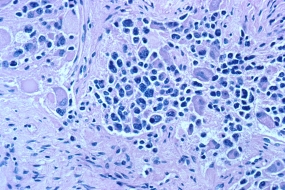Selective inhibition of a specific enzyme reduces side effects
In cases of neuroblastoma, which is an aggressive type of cancer in children, tumor growth can be slowed down by selective inhibition of a specific cancer-promoting enzyme. Scientists from the German Cancer Research Center (DKFZ) have now shown in experiments that this leads to less aggressive growth of the cancer cells. Treatment outcomes can be enhanced even further by combining the inhibitor with a vitamin A derivative that also supports the differentiation of the immature cells into neurons.
Neuroblastoma, a malignant type of tumor that occurs primarily in babies and infants, arises from cells of the embryonic nervous system. The disease can take extremely varying clinical courses, ranging from spontaneous regression to fatal outcome even after intensive treatment.
A new class of anticancer drugs might improve treatment outcomes in neuroblastoma. These substances inhibit the activity of so-called HDAC enzymes, which are a key component of the epigenetic control system of the cell and are involved in the development of cancer. Substances inhibiting HDAC enzymes slow down cancer growth, make cancer cells differentiate and restore their sensitivity for programmed cell death.
"However, the problem is that broadband HDAC inhibitors, which inhibit all members of this group of enzymes, have unpleasant side effects when administered at therapeutically effective levels," says Dr. Ina Oehme from the German Cancer Research Center (Deutsches Krebsforschungszentrum, DKFZ).
In humans, genes are known for eleven classic HDAC enzymes. The HDAC inhibitors that are currently being tested in clinical trials are non-specifically effective in all members of this enzyme family. This explains why the substances cause adverse side effects such as gastrointestinal symptoms, changes in blood cell counts, and fatigue.
Dr. Oehme and her colleagues from the DKFZ department led by Professor Dr. Olaf Witt recently showed that HDAC8 is the main culprit that drives malignant cancer growth in neuroblastoma. The scientist therefore surmised that a selective agent that exclusively inhibits HDAC8 should not affect other members of the enzyme family and hence should be tolerated much better than a broadband inhibitor.
Inga Rettig, first author of the publication, has now confirmed this hypothesis in experiments with mice that had been transplanted neuroblastoma cells. The researchers compared the substance that selectively inhibits HDAC8 with a broadband HDAC inhibitor that has already been approved for the treatment of a specific type of lymphoma. While in its clinically effective dosage the drug caused side effects, no such effects were observed after treatment with the selective agent.
Compared to the unspecific HDAC inhibitor, the selective agent was equally or even more capable of slowing down neuroblastoma growth. Tumor cells that had been treated with the HDAC8 inhibitor developed characteristics of mature neurons. Their growth rate slowed down and increasing quantities of them died from programmed cell death – a capability that has been lost in many cancer cells.
The researchers then speculated that combining the inhibitor with another agent that also promotes cell differentiation might further enhance its anticancer effect. One of these substances is retinoic acid, a vitamin A derivative. Retinoic acid is already being used as a drug in the treatment of neuroblastoma as well as specific types of blood cancer with the aim of promoting the differentiation of immature precursor cells into mature cells.
The combination of the HDAC8 inhibitor and retinoic acid in fact achieved synergistic effects, in terms of both halting growth and promoting differentiation. In addition, cells that had been treated with both substances exhibited lower levels of the cancer-promoting MYCN protein. The investigators ascribe this favorable interaction to the fact that HDAC8 and retinoic acid are molecular antagonists: Blocking the enzyme therefore promotes the differentiation of the cancer cells.
"For treating a tumor like neuroblastoma, which consists of very immature cells, we consider the combination of both substances a promising strategy," says Oehme."The goal of our research is a selective therapy of this type that attacks the growth-promoting changes in the tumor with an intelligent combination of several effective classes of substances."
The next step should be to examine whether the experimentally obtained results can be confirmed in humans. However, the specific HDAC8 inhibitors have not yet been approved for use as drugs.
I Rettig, E Koeneke, F Trippel, WC Mueller, J Burhenne, A Kopp-Schneider, J Fabian, A Schober, U Fernekorn, A von Deimling, HE Deubzer, T Milde, O Witt and I Oehme: Selective inhibition of HDAC8 decreases neuroblastoma growth in vitro and in vivo and enhances retinoic acid-mediated differentiation. Cell Death and Disease 2015, DOI: 10.1038/cddis.2015.24
With more than 3,000 employees, the German Cancer Research Center (Deutsches Krebsforschungszentrum, DKFZ) is Germany’s largest biomedical research institute. DKFZ scientists identify cancer risk factors, investigate how cancer progresses and develop new cancer prevention strategies. They are also developing new methods to diagnose tumors more precisely and treat cancer patients more successfully. The DKFZ's Cancer Information Service (KID) provides patients, interested citizens and experts with individual answers to questions relating to cancer.
To transfer promising approaches from cancer research to the clinic and thus improve the prognosis of cancer patients, the DKFZ cooperates with excellent research institutions and university hospitals throughout Germany:
The DKFZ is 90 percent financed by the Federal Ministry of Education and Research and 10 percent by the state of Baden-Württemberg. The DKFZ is a member of the Helmholtz Association of German Research Centers.


